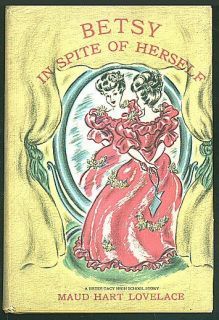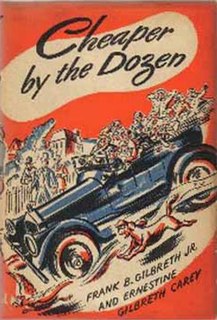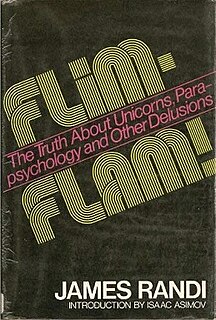 W
WBetsy and Joe (1948) is the eighth volume in the Betsy-Tacy series by Maud Hart Lovelace. This installment spans the title characters' senior, or twelfth grade, year in high school.
 W
WBetsy and Tacy Go Downtown (1943) is the fourth volume in the Betsy-Tacy series by Maud Hart Lovelace.
 W
WBetsy and Tacy Go Over the Big Hill (1942) is the third volume in the Betsy-Tacy series by Maud Hart Lovelace.
 W
WBetsy and the Great World (1952) is the ninth volume in the Betsy-Tacy series of children's fiction by Maud Hart Lovelace. The novel is set in 1914 and focuses on the newly adult Betsy Ray's adventures while spending a year traveling through Europe in place of attending college. The novel is based on the journals of the author's own trip to Europe during 1914. The novel discusses the buildup of troops in Germany prior to World War I, and also includes an account of England's declaration of war.
 W
WBetsy in Spite of Herself (1946) is the sixth volume in the Betsy-Tacy series by Maud Hart Lovelace. The story covers Betsy and Tacy's sophomore, or tenth grade, year in high school and re-introduces the character of Tib Muller, now living in Milwaukee, Wisconsin.
 W
WBetsy Was a Junior (1947) is the seventh volume in the Betsy-Tacy series by Maud Hart Lovelace. The story spans the title character's junior, or eleventh grade, year in high school.
 W
WBetsy-Tacy (1940) is the first volume in the Betsy-Tacy series by Maud Hart Lovelace.
 W
WBetsy-Tacy and Tib (1941) is the second volume in the Betsy-Tacy series by Maud Hart Lovelace. This story introduces the character of Thelma (Tib) Muller, a German-American girl who becomes friends with Betsy Ray and Tacy Kelly.
 W
WBetsy's Wedding (1955) is the tenth and final book in the Betsy-Tacy series written by Maud Hart Lovelace. Set in Minneapolis, Minnesota, the book tells the story of the early married life of the main character, Betsy Ray, and her high-school sweetheart. The characters of Tacy Kelly and Tib Muller also recur in this novel, as they did in all the novels covering the high-school years.
 W
WBridge to Terabithia is a work of children's literature about two lonely children who create a magical forest kingdom in their imaginations. It was written by Katherine Paterson and was published in 1977 by Thomas Crowell. In 1978, it won the Newbery Medal. Paterson drew inspiration for the novel from a real event that occurred in August 1974 when her son's friend was struck dead by lightning.
 W
WIn the children's book Chanticleer and the Fox, Barbara Cooney adapted and illustrated the story of Chanticleer and the Fox as told in The Nun's Priest's Tale in Chaucer's Canterbury Tales, translated by Robert Mayer Lumiansky. Published by Crowell in 1958, it was the recipient of the Caldecott Medal for illustration in 1959. It was also one of the Horn Book "best books of the year".
 W
WCheaper by the Dozen is a semi-autobiographical novel written by Frank Bunker Gilbreth Jr. and Ernestine Gilbreth Carey, published in 1948. The novel recounts the authors' childhood lives growing up in a household of 12 children. The bestselling book was later adapted into a feature film by Twentieth Century Fox in 1950 and followed up by the sequel, Belles on Their Toes (1950), which was adapted as a 1952 film.
 W
WFlim-Flam! Psychics, ESP, Unicorns, and Other Delusions is a 1980 book by magician and skeptic James Randi about paranormal, occult, and pseudoscience claims. The foreword is by science fiction author Isaac Asimov. Randi explores topics which he says that scientists and the media are too willing to promote without skepticism and proper expertise.
 W
WThe Grass Is Singing is the first novel, published in 1950, by British Nobel Prize-winning author Doris Lessing. It takes place in Southern Rhodesia, in southern Africa, during the 1940s and deals with the racial politics between whites and blacks in that country. The novel created a sensation when it was first published and became an instant success in Europe and the United States.
 W
WThe Great Gilly Hopkins is a realistic children's novel by Katherine Paterson. It was published by Crowell in 1978 and it won the U.S. National Book Award next year. In 2012 it was ranked number 63 among all-time children's novels in a survey published by School Library Journal – the third of three books by Paterson in the top 100.
 W
WHeaven to Betsy (1945) is the fifth volume in the Betsy-Tacy series by Maud Hart Lovelace. The events of the novel span Betsy and Tacy's freshman, or ninth-grade, year of school. A major character is added to the series' cast when Betsy meets Joe Willard, an orphan working for his aunt and uncle in their store at Butternut Center. The story differs from the first four books, by expanding the Betsy-Tacy-Tib circle to "The Crowd," a group of boys and girls that frequently meet at Betsy's house. Although Joe Willard was based on Maud Hart Lovelace's husband, Delos Lovelace, the book concentrates more on Betsy's adventures with the Crowd, including her self-described first love, Tony Markham, and the effect of the Crowd on Betsy's burgeoning talent for writing.
 W
WJacob Have I Loved is a coming of age novel for teenagers and young adults by Katherine Paterson. It was published by Crowell in 1980 and it won the annual Newbery Medal the following year. The title refers to the sibling rivalry between Jacob and Esau in the Jewish and Christian Bible, and comes directly from Romans 9:13: "As it is written, Jacob have I loved, but Esau have I hated."
 W
WThe Master Puppeteer (1975) is a historical novel for children by Katherine Paterson. It won the 1977 U.S. National Book Award in category Children’s Literature.
 W
WOf Nightingales That Weep is a historical novel for children by Katherine Paterson, published by Crowell in 1974. Set in medieval Japan, the novel tells the story of Takiko, the 11-year-old daughter of a slain samurai warrior. Takiko’s mother remarries Goro, a gentle but unattractive potter/dwarf, whom Takiko fears. When she matures into adulthood, Takiko is able to find employment in the court of the Japanese emperor and falls in love with an enemy spy-Hideo. Eventually, she returns home and is able to reconcile her feelings towards Goro.
 W
WOnion John is a novel by American writer Joseph Krumgold, published in 1959. It was the winner of the 1960 Newbery Medal. The story is set in 1950s New Jersey, and tells the story of 12-year-old Andy Rusch and his friendship with an eccentric hermit who lives on the outskirts of the small town of Serenity.
 W
WRevolt on Alpha C is a juvenile science fiction novel by American writer Robert Silverberg, published by Crowell in 1955. It was Silverberg's first published book.
 W
WThe Sign of the Chrysanthemum is a 1973 work of literature that was the first published work by the American novelist Katherine Paterson. The novel is set in 12th century Japan and tells the story of Muna, a 14-year-old who searches for his long-absent father following his mother's death.
 W
WA Taste of Blackberries is an award-winning children's book by Doris Buchanan Smith.
 W
WThe Upstairs Room is a 1972 Holocaust survivor autobiography by Johanna Reiss documenting her childhood in occupied Holland during the Nazi invasion.
 W
WThe White Company is a historical adventure by British writer Arthur Conan Doyle, set during the Hundred Years' War. The story is set in England, France, and Spain, in the years 1366 and 1367, against the background of the campaign of Edward, the Black Prince, to restore Peter of Castile to the throne of the Kingdom of Castile. The climax of the book occurs before the Battle of Nájera. Doyle became inspired to write the novel after attending a lecture on the Middle Ages in 1889. After extensive research, The White Company was published in serialized form in 1891 in Cornhill Magazine. Additionally, the book is considered a companion to Doyle's later work Sir Nigel, which explores the early campaigns of Sir Nigel Loring and Samkin Aylward.
 W
WWith Child: A Diary of Motherhood is a non-fiction book by Phyllis Chesler, a feminist who gave birth to a son, published on October 26, 1979 by T. Y. Crowell.